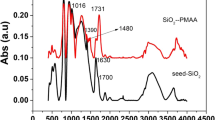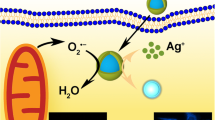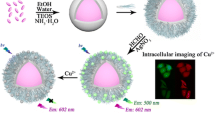Abstract
In this contribution, we present a highly selective chromium ion (Cr3+)-induced aggregation of citrate-capped silver nanoparticles, which could be applied for the imaging of the distribution of Cr3+ in cells. It was found that selective aggregation of citrate-capped silver nanoparticles occurs at room temperature in the presence of Cr3+ in aqueous medium of pH 6.8, resulting in color change from yellow to pink in 10 min and enhanced localized surface plasmon resonance (LSPR) scattering signals. Tenfold of other metal ions including Al3+, Ca2+, Co2+, Cu2+, Fe2+, Fe3+, Hg2+, La3+, Mg2+, Ni2+, Pb2+, Tb3+ and Zn2+ had no response. Mechanism analysis showed that the aggregation is mainly dependent on the chelation of Cr3+ ion with the citrate ion capped on silver nanoparticles, forming crosslinking aggregates of silver nanoparticles. With the Cr3+-induced enhancement of LSPR scattering signals, Cr3+ in cytoplasm of human bone marrow neuroblastoma cells could be imaged with dark-field light scattering imaging technique.






Similar content being viewed by others
References
Lee KS, El-Sayed MA (2006) Gold and silver nanoparticles in sensing and imaging: Sensitivity of plasmon response to size, shape, and metal composition. J Phys Chem B 110:19220–19225
Kim F, Song JH, Yang P (2002) Photochemical synthesis of gold nanorods. J Am Chem Soc 124:14316–14317
Sato K, Hosokawa K, Maeda M (2007) Colorimetric biosensors based on DNA-nanoparticle conjugates. Anal Sci 23:17–20
Zhao W, Brook MA, Li YF (2008) Design of gold nanoparticle-based colorimetric biosensing assays. Chembiochem 9:2363–2371
Li HX, Rothberg L (2004) Colorimetric detection of DNA sequences based on electrostatic interactions with unmodified gold nanoparticles. P Natl Acad Sci USA 101:14036–14039
Oishi J, Asami Y, Mori T, Kang JH, Niidome T, Katayama Y (2008) Colorimetric enzymatic activity assay based on noncrosslinking aggregation of gold nanoparticles induced by adsorption of substrate peptides. Biomacromolecules 9:2301–2308
Chen Z, Luo SL, Liu CB, Cai QY (2009) Simple and sensitive colorimetric detection of cysteine based on ssDNA-stabilized gold nanoparticles. Anal Bioanal Chem 395:489–494
Liu CW, Hsieh YT, Huang CC, Lin ZH, Chang HT (2008) Detection of mercury (II) based on Hg2+-DNA complexes inducing the aggregation of gold nanoparticles. Chem Commun:2242–2244
Li D, Wieckowska A, Willner I (2008) Optical analysis of Hg2+ ions by oligonucleotide-gold-nanoparticle hybrids and DNA-based machines. Angew Chem Int Edit 47:3927–3931
Wang ZD, Lee JH, Lu Y (2008) Label-free colorimetric detection of lead ions with a nanomolar detection limit and tunable dynamic range by using gold nanoparticles and DNAzyme. Adv Mater 20:3263–3267
Lin SY, Liu SW, Lin CM, Chen CH (2002) Recognition of potassium ion in water by 15-crown-5 functionalized gold nanoparticles. Anal Chem 74:330–335
Lee JS, Ulmann PA, Han MS, Mirkin CA (2008) A DNA-gold nanoparticle-based colorimetric competition assay for the detection of cysteine. Nano Lett 8:529–533
He XR, Liu HB, Li YL, Wang S, Li YJ, Wang N, Xiao JC, Xu XH, Zhu DB (2005) Gold nanoparticle-based fluorometric and colorimetric sensing of copper(II) ions. Adv Mater 17:2811–2815
Obare SO, Hollowell RE, Murphy CJ (2002) Sensing strategy for lithium ion based on gold nanoparticles. Langmuir 18:10407–10410
Li L, Li BX, Qi YY, Jin Y (2009) Label-free aptamer-based colorimetric detection of mercury ions in aqueous media using unmodified gold nanoparticles as colorimetric probe. Anal Bioanal Chem 393:2051–2057
Preuss HG, Echard B, Perricone NV, Bagchi D, Yasmin T, Stohs SJ (2008) Comparing metabolic effects of six different commercial trivalent chromium compounds. J Inorg Biochem 102:1986–1990
McCarty MF (1993) Homologous physiological effects of phenformin and chromium picolinate. Med Hypotheses 41:316–324
Broadhurst CL, Domenico P (2006) Clinical studies on chromium picolinate supplementation in diabetes mellitus—a review. Diabetes Technol Ther 8:677–687
Chen F, Bower J, Leonard SS, Ding M, Lu Y, Rojanasakul Y, Kung H-f, Vallyathan V, Castranova V, Shi X (2002) Protective roles of NF-kappa B for chromium(VI)-induced cytotoxicity is revealed by expression of Ikappa B kinase-beta mutant. J Biol Chem 277:3342–3349
Li Chen T, Wise SS, Holmes A, Shaffiey F, Wise JP, Thompson WD, Kraus S (2009) Cytotoxicity and genotoxicity of hexavalent chromium in human and North Atlantic right whale (Eubalaena glacialis) lung cells. Comp Biochem Physiol C Toxicol Pharmacol 150:487–494
Luo JH, Zhang ZJ, Chen DL, Shu WQ, Wang ZP (2005) Flow-injection chemiluminescence as a means of studying the metabolism of unbound chromium(III) in rabbit blood with on-line microdialysis sampling. Microchim Acta 150:311–316
Zhou ZG, Yu MX, Yang H, Huang KW, Li FY, Yi T, Huang CH (2008) FRET-based sensor for imaging chromium(III) in living cells. Chem Commun:3387–3389
Yu FB, Zhang WS, Li P, Xing YL, Tong LL, Ma JP, Tang B (2009) Cu2+-selective naked-eye and fluorescent probe: its crystal structure and application in bioimaging. Analyst 134:1826–1833
Zhao Y, Zhang XB, Han ZX, Qiao L, Li CY, Jian LX, Shen GL, Yu RQ (2009) Highly sensitive and selective colorimetric and off-on fluorescent chemosensor for Cu2+ in aqueous solution and living cells. Anal Chem 81:7022–7030
Doty RC, Tshikhudo TR, Brust M, Fernig DG (2005) Extremely stable water-soluble Ag nanoparticles. Chem Mater 17:4630–4635
Evanoff DD, Chumanov G (2004) Size-controlled synthesis of nanoparticles. 2. Measurement of extinction, scattering, and absorption cross sections. J Phys Chem B 108:13957–13962
Ling J, Sang Y, Huang CZ (2008) Visual colorimetric detection of berberine hydrochloride with silver nanoparticles. J Pharmaceut Biomed 47:860–864
Si S, Kotal A, Mandal TK (2007) One-dimensional assembly of peptide-functionalized gold nanoparticles: an approach toward mercury ion sensing. J Phys Chem C 111:1248–1255
Wei H, Chen CG, Han BY, Wang EK (2008) Enzyme colorimetric assay using unmodified silver nanoparticles. Anal Chem 80:7051–7055
Wu LP, Li YF, Huang CZ, Zhang Q (2006) Visual detection of Sudan dyes based on the plasmon resonance light scattering signals of silver nanoparticles. Anal Chem 78:5570–5577
He W, Li YF, Huang CZ, Xie JP, Yang RG, Zhou PF, Wang J (2008) A one-step label-free optical genosensing system for sequence-specific DNA related to the human immunodeficiency virus based on the measurements of light scattering signals of gold nanorods. Anal Chem 80:8424–8430
Zhang L, Huang CZ, Li YF, Xiao SJ, Xie JP (2008) Label-free detection of sequence-specific DNA with multiwalled carbon nanotubes and their light scattering signals. J Phys Chem B 112:7120–7122
Wang J, Li YF, Huang CZ, Wu T (2008) Rapid and selective detection of cysteine based on its induced aggregates of cetyltrimethylammonium bromide capped gold nanoparticles. Anal Chim Acta 626:37–43
Pillai ZS, Kamat PV (2004) What factors control the size and shape of silver nanoparticles in the citrate ion reduction method? J Phys Chem B 108:945–951
Wulandari P, Li XH, Tamada K, Hara M (2008) Conformational study of citrates adsorbed on gold nanoparticles using Fourier transform infrared spectroscopy. J Nonlinear Opt Phys 17:185–192
Mpourmpakis G, Vlachos DG (2008) Insights into the early stages of metal nanoparticle formation via first-principle calculations: the roles of citrate and water. Langmuir 24:7465–7473
Maillard M, Huang PR, Brus L (2003) Silver nanodisk growth by surface plasmon enhanced photoreduction of adsorbed [Ag+]. Nano Lett 3:1611–1615
Acknowledgments
We greatly appreciate the financial supports of the Ministry of Science and Technology of the People’s Republic of China (No. 2006CB 933100), and the National Natural Science Foundation of China (No. 20877063).
Author information
Authors and Affiliations
Corresponding author
Electronic supplementary material
Below is the link to the electronic supplementary material.
ESM 1
(PDF 1737 kb)
Rights and permissions
About this article
Cite this article
Wu, T., Liu, C., Tan, K.J. et al. Highly selective light scattering imaging of chromium (III) in living cells with silver nanoparticles. Anal Bioanal Chem 397, 1273–1279 (2010). https://doi.org/10.1007/s00216-010-3619-6
Received:
Accepted:
Published:
Issue Date:
DOI: https://doi.org/10.1007/s00216-010-3619-6




